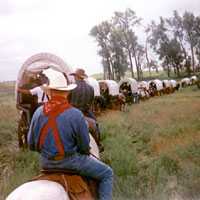 |

小徑彎道上的篷車及騎士。
北達科他州境內,位於詹姆斯城附近的派普斯通水源區(Pipestone
Reservoir area),1998年6月

|
 |
|
 |
福特西渥德(Fort
Seward)的篷車隊伍
地方性遺產
您知道篷車隊伍是什麼嗎?
19世紀時,美國境內的殖民若想要搬離西部地區,他們通常會集結成群並搭乘架有棚子的四輪馬車進行旅程。人們會在早春時集合併在四輪馬車隊伍正式啟程前,僱用嚮導、選出領袖並集結日常用品。
每年夏季,位於北達科他州,詹姆斯城(Jamestown)附近的福特西渥德會聚集100多人。他們會過著如當初的拓荒者家庭一般的生活並重新體驗四輪蓬車隊伍的生涯。連續一星期的時間,他們會搭乘由騾子或馬匹在前負責拖拉,架有篷頂的馬車。他們的餐點則由一台裝有食物的篷車負責供應。參加此趟旅程的乘客會身穿19世紀晚期的服裝,女士會穿上長裙、圍裙,頭戴有帶子的帽子,而男士則會穿上背心及背帶。每天晚上,蓬車會面向營火圍成一個圓圈,而領隊的騎士則會跟他人分享他的故事、音樂及工藝品,就像一世紀以前,早期的美國拓荒者所做的事一般。
Do you know what a wagon train is?
During the 19th century, settlers in the United States who wanted to move out West usually traveled by covered wagons in large groups. People would meet in the early spring to hire guides, elect leaders, and gather supplies before leaving on their journey as a wagon train.
Every summer, more than 100 people meet at Fort Seward, near Jamestown, North Dakota, to re-enact the wagon train experience and live like pioneer families. For a week, they travel in canvas-covered wagons pulled by mules or workhorses. A "chuck" wagon provides their meals. Everyone dresses in late-19th century-style clothing. Women wear long dresses, aprons, and bonnets, and men wear vests and suspenders. Every night, the wagons circle around a campsite, and trail riders share stories, music and crafts, just as the early American pioneers did over a century ago.
1/1 頁

關於地方性遺產

|





